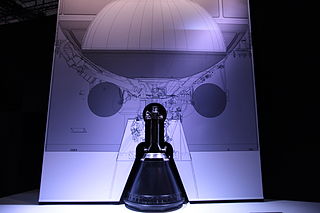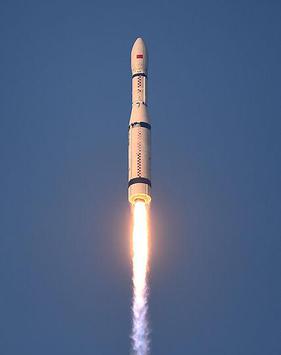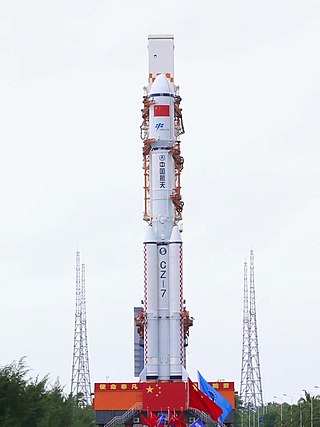Related Research Articles
The Long March rockets are a family of expendable launch system rockets operated by the China Aerospace Science and Technology Corporation. The rockets are named after the Chinese Red Army's 1934–35 Long March military retreat during the Chinese Civil War.

A liquid-propellant rocket or liquid rocket utilizes a rocket engine burning liquid propellants. (Alternate approaches use gaseous or solid propellants.) Liquids are desirable propellants because they have reasonably high density and their combustion products have high specific impulse (Isp). This allows the volume of the propellant tanks to be relatively low.
The highest specific impulse chemical rockets use liquid propellants. They can consist of a single chemical or a mix of two chemicals, called bipropellants. Bipropellants can further be divided into two categories; hypergolic propellants, which ignite when the fuel and oxidizer make contact, and non-hypergolic propellants which require an ignition source.

The staged combustion cycle is a power cycle of a bipropellant rocket engine. In the staged combustion cycle, propellant flows through multiple combustion chambers, and is thus combusted in stages. The main advantage relative to other rocket engine power cycles is high fuel efficiency, measured through specific impulse, while its main disadvantage is engineering complexity.

The gas-generator cycle, also called open cycle, is one of the most commonly used power cycles in bipropellant liquid rocket engines. Part of the unburned propellant is burned in a gas generator and the resulting hot gas is used to power the propellant pumps before being exhausted overboard, and lost. Because of this loss, this type of engine is termed open cycle.

Vinci is a European Space Agency cryogenic liquid rocket engine under development as of 2020. It is designed to power the new upper stage of Ariane 6.

The YF-77 is China's first cryogenic rocket engine developed for booster applications. It burns liquid hydrogen fuel and liquid oxygen oxidizer using a gas generator cycle. A pair of these engines powers the LM-5 core stage. Each engine can independently gimbal in two planes. Although the YF-77 is ignited prior to liftoff, the LM-5's four strap-on boosters provide most of the initial thrust in an arrangement similar to the European Vulcain on the Ariane 5 or the Japanese LE-7 on the H-II.

The YF-100 is a Chinese liquid rocket engine burning LOX and kerosene in an oxidizer-rich staged combustion cycle.

The Long March 6 or Chang Zheng 6 as in pinyin, abbreviated LM 6 for export or CZ 6 within China, is a Chinese liquid-fuelled launch vehicle of the Long March family, which was developed by the China Aerospace Science and Technology Corporation (CASC) and the Shanghai Academy of Spaceflight Technology (SAST). The rocket was developed in the 2000s, and made its maiden flight in 2015. As one of the new generation rocket family, the Long March 6 was designed to be a light capacity, "high-speed response" rocket, complementing the heavy lift Long March 5 and the mid-heavy lift Long March 7 rocket families. It is capable of placing at least 1,000 kg (2,200 lb) of payload into a Sun-synchronous orbit. The first stage of the Long March 6 was derived from the booster rockets being developed for the Long March 5 rocket. It is powered by a YF-100 engine, which generates 1,340 kN (300,000 lbf) of thrust from burning kerosene and LOX as rocket fuel and oxidiser. This was the first flight of the new engine design.

The Long March 7, or Chang Zheng 7 in pinyin, abbreviated LM-7 for export or CZ-7 within China, originally Long March 2F/H or Chang Zheng 2F/H, nicknamed Bingjian, is a Chinese liquid-fuelled launch vehicle of the Long March family, developed by the China Aerospace Science and Technology Corporation (CAST). It made its inaugural flight on 25 June 2016.
The RD-120 is a liquid upper stage rocket engine burning RG-1 and LOX in an oxidizer rich staged combustion cycle with an O/F ratio of 2.6. It is used in the second stage of the Zenit family of launch vehicles. It has a single, fixed combustion chamber and thus on the Zenit it is paired with the RD-8 vernier engine. The engine was developed from 1976 to 1985 by NPO Energomash with V.P. Radovsky leading the development. It is manufactured by, among others, Yuzhmash in Ukraine.

Since the founding of SpaceX in 2002, the company has developed four families of rocket engines — Merlin, Kestrel, Draco and SuperDraco — and is currently developing another rocket engine: Raptor, and after 2020, a new line of methalox thrusters.

Long March 9 is a Chinese super-heavy carrier rocket that is currently under development. It is the ninth iteration of the Long March rocket family, named for the Chinese Red Army's 1934–35 Long March campaign during the Chinese Civil War.

The SCE-200 is a 2 MN thrust class liquid rocket engine, being developed to power ISRO's existing LVM3 and upcoming heavy and super heavy-lift launch vehicles. It is being developed by Liquid Propulsion Systems Centre (LPSC) of ISRO and is expected to have first flight in 2020s.
The YF-115 is a Chinese liquid rocket engine burning LOX and kerosene in an oxidizer-rich staged combustion cycle. A high efficiency/high thrust environmental-friendly rocket engine was always an objective within Programme 863. Development began in the 2000s, along with its sibling, the bigger YF-100, which would power the LM-5, LM-6 and LM-7 boosters and first stages. Testing was directed by the China National Space Administration (CNSA) commencing in 2005. Development works are mainly carried out by the Xi'an Aerospace Propulsion Institute. It will be used as upper stage engine for China's next generation of medium and light environmental-friendly launch vehicles, namely the Long March 6 and the Long March 7. During early 2012, the engine system successfully passed vacuum testing. It is China's first upper stage rocket engine to adopt the staged-combustion cycle.

Starship is a two-stage super heavy-lift launch vehicle under development by SpaceX. As of May 2024, it is the largest and most powerful rocket ever flown. Starship's primary objective is to lower launch costs significantly via economies of scale. This is achieved by reusing both rocket stages, increasing payload mass to orbit, increasing launch frequency, creating a mass-manufacturing pipeline, and adapting it to a wide range of space missions. Starship is the latest project in SpaceX's decades-long reusable launch system development program and ambition of colonizing Mars.

Raptor is a family of rocket engines developed and manufactured by SpaceX. The engine is a full-flow staged combustion cycle (FFSC) engine powered by cryogenic liquid methane and liquid oxygen ("methalox").
The YF-130 is a Chinese rocket engine fueled by LOX and kerosene in an oxidizer-rich staged combustion cycle currently in development. It has been designed to reach around 500 tonnes of thrust and it will power the super heavy Long March 9 rocket.

Long March 10, also known as the “Next Generation crewed launch vehicle”, and previously and unoffically as the “921 rocket” or the "Long March 5G", is a Chinese super-heavy carrier rocket for crewed lunar missions that is currently under development. The nickname "921" refers to the founding date of China's human spaceflight program. In 2022, the first flight of the Long March 10 was targeted for 2027. By January 2024, the first flight's target was moved up to 2025-26.In an April 2024 update, it was announced that program development of the vehicle was complete.
The YF-90 is a liquid cryogenic rocket engine burning liquid hydrogen and liquid oxygen in a staged combustion cycle. It is China's first hydrogen-oxygen engine to use the staged combustion cycle and is expected to be used for the second stage of the Long March 9, which is a three-stage rocket with boosters. The engine has advanced features such as variable thrust, multiple ignitions, and automatic fault diagnosis.
References
- ↑ Jones, Andrew (27 November 2023). "China makes progress on Raptor-like engines for super heavy rocket". SpaceNews. Retrieved 21 May 2024.
- ↑ Beil, Adrian (17 May 2023). "Beidou-3 G4 gets launched and Chinese Raptor gets tested, as it receives its own name". NASASpaceFlight.com. Retrieved 21 May 2024.
